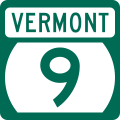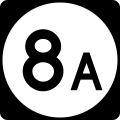Johnsninja58 (talk | contribs) |
Johnsninja58 (talk | contribs) |
||
| Line 54: | Line 54: | ||
===Locking roads=== | ===Locking roads=== | ||
Vermont has adopted the [[USA/New_England#Locking_Roads|New England Road Type Locking Standard]]. | |||
===Functional Classification=== | ===Functional Classification=== | ||
Revision as of 14:56, 22 July 2019
Highway Numbering
Vermont currently observes the following Standardized Name nomenclature for Numbered Routes:
| Road Type | Standardized Name |
|---|---|
| Freeways | I-### |
| US Highways | US-### |
| State Highways | VT-### |
| Town Highway | TH-### |
State Highway numbering includes spurs and loops (E.g. VT-67A).
These naming conventions should also be applied to "Old" numbered routes that have become local streets after the completion of new highway alignments. For example, "Old State Rte ##" and "Old US Hwy ##" Should be renamed "Old VT-##" and "Old US-##" respectively. In some cases, it may be necessary to research whether the old route was formerly a state or US highway.
State Highway Signage
Most state highways are maintained by the Vermont Agency of Transportation (VTrans). However, some entire routes, and portions of others, are maintained by local governments, such as towns or cities, instead. These town-maintained routes are internally called "state-designated town highways" and are typically designated as "class 1 town highways".
VTrans uses a different type of signage for each:
 Vermont State Route signage (maintained by VTrans)
Vermont State Route signage (maintained by VTrans)
 Vermont State Route signage (maintained by local jurisdiction)
Vermont State Route signage (maintained by local jurisdiction)
Map editors should treat both types of state highways the same when dealing with road types.
Road Elevations
These are the general guidelines for elevation in Vermont. Note that these guidelines are currently under revision on the National level, and are subject to change:
- Drivable and non-drivable segments are handled the same way with elevation.
- Set elevation to Ground on all non-tunneled segments that are not passing over/beneath another segment or waterway.
- Only segments that "cannot see the sky" should have negative elevation (i.e. tunnels).
- Only set elevation as high as necessary.
- Elevation of overlapping segments should be set relative to each other, with the lowest segment as Ground (unless a tunnel).
- If you use the Bridge tool to join segments, be aware that it raises the elevation of the joined segment. Lower the joined segment as appropriate.
Highway Naming
See Road names and Road types for general guidelines for naming and classifying roads.
Regarding Local and Alternate Names:
In situations where a highway passes through a town, the road in those areas is typically named something other than the numbered route. In these situations the road should be named based on the following conditions:
- If the local street signs provide guidance with the local name, that should be used as the primary name in the Waze map. The numbered route should be added as an alternate name.
- If the local signs only indicate the route number, then that should be the primary name and the local road name should be added as an alternate name.
Locking roads
Vermont has adopted the New England Road Type Locking Standard.
Functional Classification
